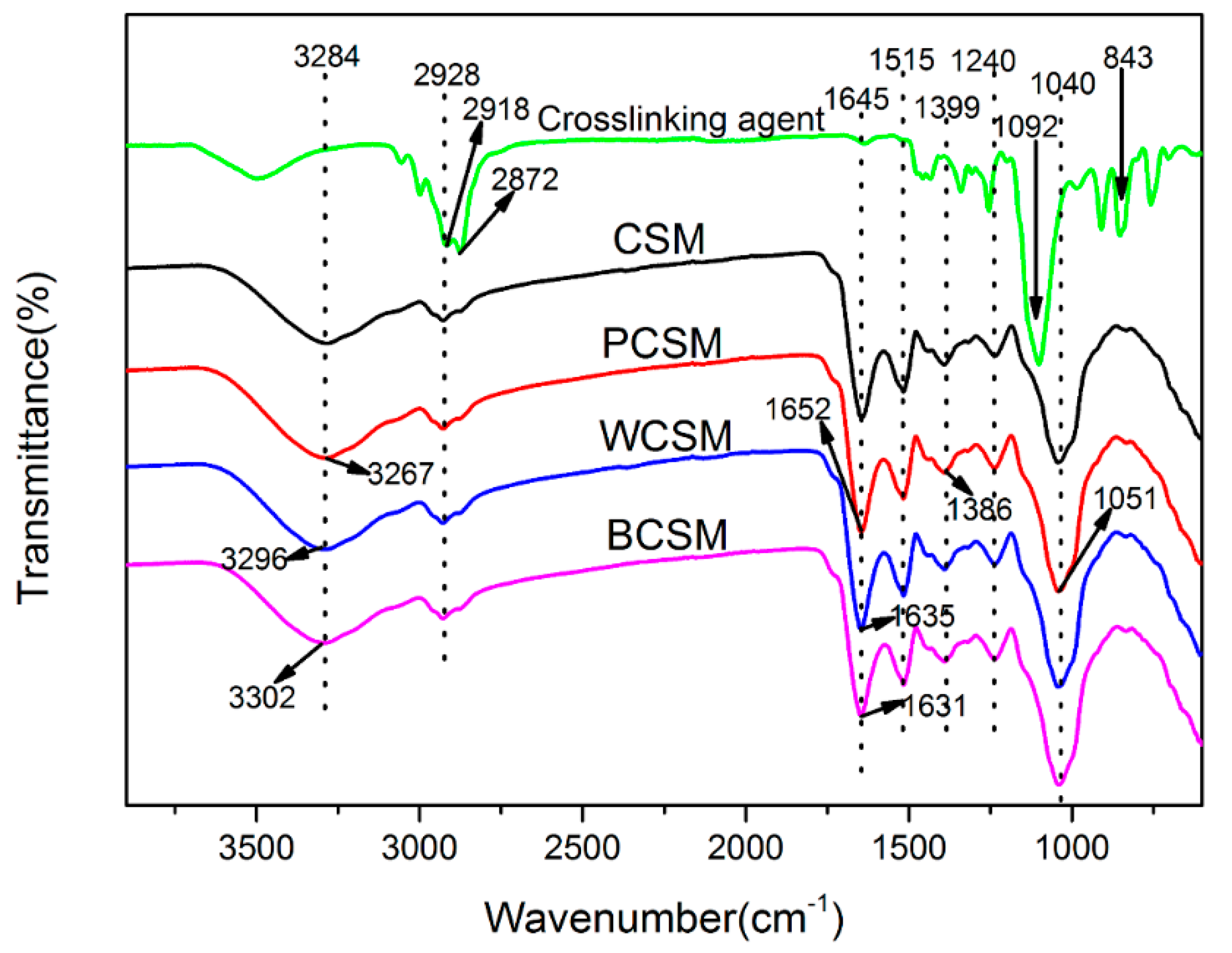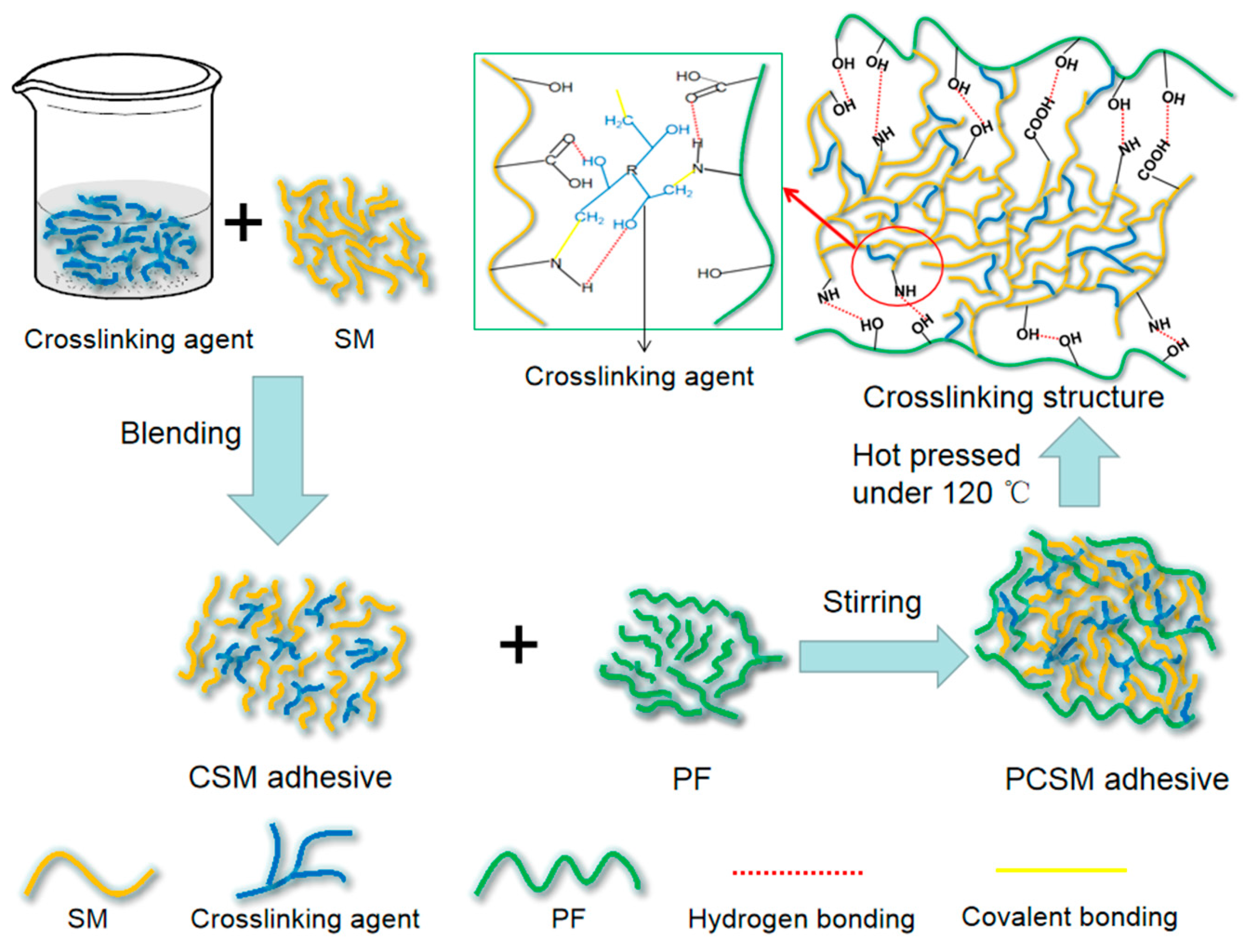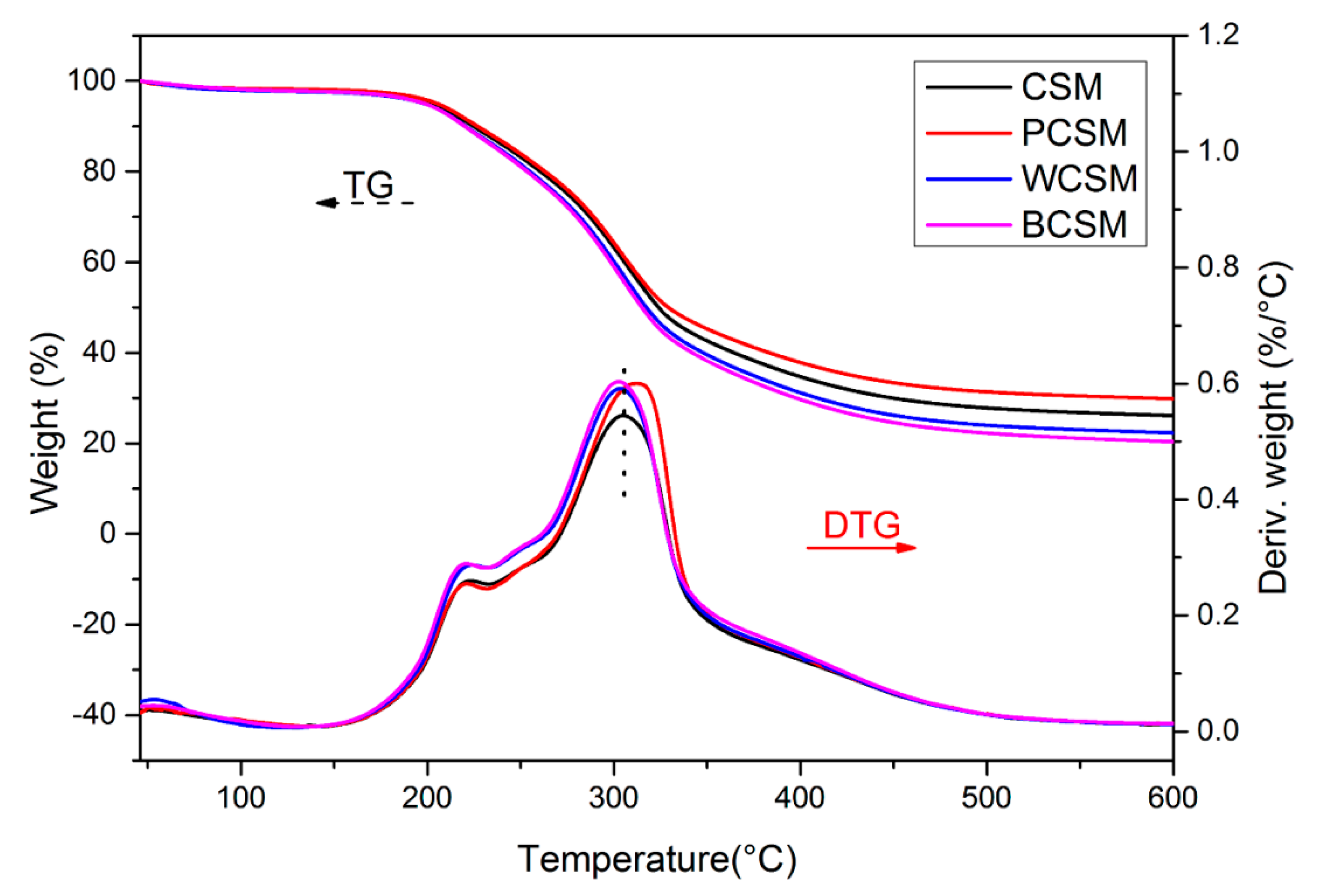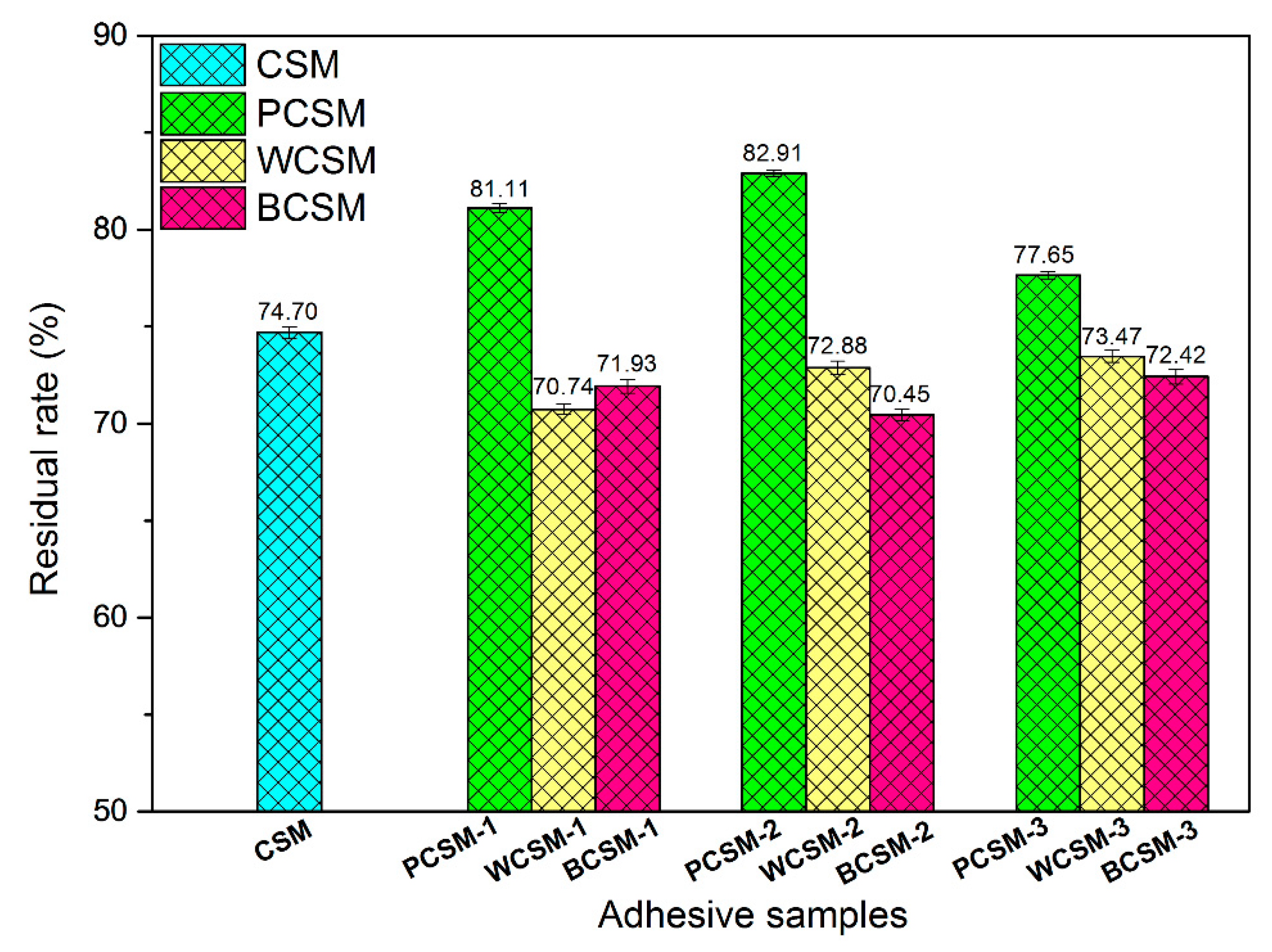Reinforcement of Bonding Strength and Water Resistance of Soybean Meal-Based Adhesive via Construction of an Interactive Network from Biomass Residues
Abstract
1. Introduction
2. Experimental Procedures
2.1. Materials
2.2. Pre-Treatment of Natural Fibers
2.3. The SM-Based Adhesive Preparation
2.4. Triple-Layered Plywood Specimen Preparation
2.5. Characterization of PF, WF, BF, and the Adhesive Samples
2.5.1. ATR-FTIR Spectroscopy
2.5.2. Thermogravimetric Analysis
2.5.3. Scanning Electron Microscopy
2.5.4. Apparent Viscosity Measurement
2.5.5. Residue Rate Test
2.5.6. Dry and Wet Shear Strength Measurements
2.5.7. Statistical Analysis
3. Results and Discussion
3.1. Structural Analysis of the Adhesives
3.1.1. ATR-FTIR Spectroscopy Results
3.1.2. Thermogravimetric Analysis
3.1.3. Micromorphological Analysis
3.1.4. Apparent Viscosity Analyses
3.1.5. Residue Rate Analyses
3.2. The Effect of Different Fibers on SM-Based Adhesive Mechanical Properties
Dry and Wet Shear Strength Measurements
4. Conclusions
Author Contributions
Funding
Conflicts of Interest
Nomenclature
| SM | Soybean meal |
| CSM | SM-based adhesive only modified by the crosslinking agent |
| PCSM adhesives | CSM adhesives modified by pulp fiber |
| WCSM adhesives | CSM adhesives modified by poplar wood fiber |
| BCSM adhesives | CSM adhesives modified by bagasse fiber |
| ATR-FTIR | Attenuated total reflection–Fourier transform infrared spectroscopy |
| TGA | Thermogravimetry |
| DTG | Derivative thermogravimetry |
References
- Vnučec, D.; Kutnar, A.; Goršek, A. Soy-based adhesives for wood-bonding—A review. J. Adhes. Sci. Technol. 2016, 31, 910–931. [Google Scholar] [CrossRef]
- Wang, Z.; Kang, H.; Zhang, W.; Zhang, S.; Li, J. Improvement of interfacial adhesion by bio-inspired catechol-functionalized soy protein with versatile reactivity: Preparation of fully utilizable soy-based film. Polymers 2017, 9, 95. [Google Scholar] [CrossRef] [PubMed]
- Wang, L.; Li, J.; Zhang, S.; Shi, J. Preparation and characterization of all-biomass soy protein isolate-based films enhanced by epoxy castor oil acid sodium and hydroxypropyl cellulose. Materials 2016, 9, 193. [Google Scholar] [CrossRef] [PubMed]
- Zhao, S.; Wang, Z.; Kang, H.; Li, J.; Zhang, S.; Han, C.; Huang, A. Fully bio-based soybean adhesive in situ cross-linked by interactive network skeleton from plant oil-anchored fiber. Ind. Crops Prod. 2018, 122, 366–374. [Google Scholar] [CrossRef]
- Xu, F.; Dong, Y.; Zhang, W.; Zhang, S.; Li, L.; Li, J. Preparation of cross-linked soy protein isolate-based environmentally-friendly films enhanced by ptge and pam. Ind. Crops Prod. 2015, 67, 373–380. [Google Scholar] [CrossRef]
- Zhang, S.; Xia, C.; Dong, Y.; Yan, Y.; Li, J.; Shi, S.Q.; Cai, L. Soy protein isolate-based films reinforced by surface modified cellulose nanocrystal. Ind. Crops Prod. 2016, 80, 207–213. [Google Scholar] [CrossRef]
- Wang, Z.; Zhao, S.; Pang, H.; Zhang, W.; Zhang, S.; Li, J. Developing eco-friendly high-strength soy adhesives with improved ductility through multiphase core–shell hyperbranched polysiloxane. ACS Sustain. Chem. Eng. 2019, 7, 7784–7794. [Google Scholar] [CrossRef]
- Pradyawong, S.; Qi, G.; Li, N.; Sun, X.S.; Wang, D. Adhesion properties of soy protein adhesives enhanced by biomass lignin. Int. J. Adhes. Adhes. 2017, 75, 66–73. [Google Scholar] [CrossRef]
- Friesen, K.; Chang, C.; Nickerson, M. Incorporation of phenolic compounds, rutin and epicatechin, into soy protein isolate films: Mechanical, barrier and cross-linking properties. Food Chem. 2015, 172, 18–23. [Google Scholar] [CrossRef] [PubMed]
- Li, H.; Li, C.; Gao, Q.; Zhang, S.; Li, J. Properties of soybean-flour-based adhesives enhanced by attapulgite and glycerol polyglycidyl ether. Ind. Crops Prod. 2014, 59, 35–40. [Google Scholar] [CrossRef]
- Garrido, T.; Etxabide, A.; Guerrero, P.; de la Caba, K. Characterization of agar/soy protein biocomposite films: Effect of agar on the extruded pellets and compression moulded films. Carbohydr. Polym. 2016, 151, 408–416. [Google Scholar] [CrossRef] [PubMed]
- González, A.; Alvarez Igarzabal, C.I. Nanocrystal-reinforced soy protein films and their application as active packaging. Food Hydrocoll. 2015, 43, 777–784. [Google Scholar] [CrossRef]
- Wu, Y.; Cai, L.; Wang, C.; Mei, C.; Shi, S.Q. Sodium hydroxide-free soy protein isolate-based films crosslinked by pentaerythritol glycidyl ether. Polymers 2018, 10, 1300. [Google Scholar] [CrossRef] [PubMed]
- Xia, C.; Zhang, S.; Shi, S.Q.; Cai, L.; Garcia, A.C.; Rizvi, H.R.; D’Souza, N.A. Property enhancement of soy protein isolate-based films by introducing poss. Int. J. Biol. Macromol. 2016, 82, 168–173. [Google Scholar] [CrossRef] [PubMed]
- Bigi, A.; Cojazzi, G.; Panzavolta, S.; Rubini, K.; Roveri, N. Mechanical and thermal properties of gelatin films at different degrees of glutaraldehyde crosslinking. Biomaterials 2001, 22, 763–768. [Google Scholar] [CrossRef]
- Kamar, N.T.; Hossain, M.M.; Khomenko, A.; Haq, M.; Drzal, L.T.; Loos, A. Interlaminar reinforcement of glass fiber/epoxy composites with graphene nanoplatelets. Compos. Part A Appl. Sci. Manuf. 2015, 70, 82–92. [Google Scholar] [CrossRef]
- Maxim, L.D.; Utell, M.J. Review of refractory ceramic fiber (rcf) toxicity, epidemiology and occupational exposure. Inhal. Toxicol. 2018, 30, 49–71. [Google Scholar] [CrossRef] [PubMed]
- Vecchio, K.S.; Jiang, F. Fracture toughness of ceramic-fiber-reinforced metallic-intermetallic-laminate (cfr-mil) composites. Mater. Sci. Eng. A 2016, 649, 407–416. [Google Scholar] [CrossRef]
- Liu, X.; Wang, K.; Zhang, W.; Qi, C.; Zhang, S.; Li, J. Hybrid hnts-kenaf fiber modified soybean meal-based adhesive with ptge for synergistic reinforcement of wet bonding strength and toughness. Int. J. Adhes. Adhes. 2018, 87, 173–180. [Google Scholar] [CrossRef]
- Yang, Z.; Feng, X.; Bi, Y.; Zhou, Z.; Yue, J.; Xu, M. Bleached extruder chemi-mechanical pulp fiber-pla composites: Comparison of mechanical, thermal, and rheological properties with those of wood flour-pla bio-composites. J. Appl. Polym. Sci. 2016, 133, 44241. [Google Scholar] [CrossRef]
- Nourbakhsh, A.; Ashori, A.; Kargarfard, A. Evaluation of multi-walled carbon nanotubes as reinforcement for natural fiber-based composites. Polym. Compos. 2016, 37, 3269–3274. [Google Scholar] [CrossRef]
- Balaji, A.; Karthikeyan, B.; Swaminathan, J.; Sundar Raj, C. Mechanical behavior of short bagasse fiber reinforced cardanol-formaldehyde composites. Fibers Polym. 2017, 18, 1193–1199. [Google Scholar] [CrossRef]
- Duan, H.; Qiu, T.; Guo, L.; Ye, J.; Li, X. The microcapsule-type formaldehyde scavenger: The preparation and the application in urea-formaldehyde adhesives. J. Hazard. Mater. 2015, 293, 46–53. [Google Scholar] [CrossRef] [PubMed]
- White, R.J.; Shuttleworth, P.S.; Budarin, V.L.; De Bruyn, M.; Fischer, A.; Clark, J.H. An interesting class of porous polymer–revisiting the structure of mesoporous alpha-d-polysaccharide gels. ChemSusChem 2016, 9, 280–288. [Google Scholar] [CrossRef] [PubMed]
- Yang, S.; Madbouly, S.A.; Schrader, J.A.; Srinivasan, G.; Grewell, D.; McCabe, K.G.; Kessler, M.R.; Graves, W.R. Characterization and biodegradation behavior of bio-based poly(lactic acid) and soy protein blends for sustainable horticultural applications. Green Chem. 2015, 17, 380–393. [Google Scholar] [CrossRef]
- Kim, J.H.; Park, S.-K.; Oh, Y.J.; Kang, Y.C. Hierarchical hollow microspheres grafted with co nanoparticle-embedded bamboo-like n-doped carbon nanotube bundles as ultrahigh rate and long-life cathodes for rechargeable lithium-oxygen batteries. Chem. Eng. J. 2018, 334, 2500–2510. [Google Scholar] [CrossRef]
- Kang, H.; Wang, Z.; Zhang, W.; Li, J.; Zhang, S. Physico-chemical properties improvement of soy protein isolate films through caffeic acid incorporation and tri-functional aziridine hybridization. Food Hydrocoll. 2016, 61, 923–932. [Google Scholar] [CrossRef]
- Kang, H.; Song, X.; Wang, Z.; Zhang, W.; Zhang, S.; Li, J. High-performance and fully renewable soy protein isolate-based film from microcrystalline cellulose via bio-inspired poly(dopamine) surface modification. ACS Sustain. Chem. Eng. 2016, 4, 4354–4360. [Google Scholar] [CrossRef]
- Chen, L.; Subirade, M. Elaboration and characterization of soy/zein protein microspheres for controlled nutraceutical delivery. Biomacromolecules 2009, 10, 3327–3334. [Google Scholar] [CrossRef]
- Liu, X.; Wang, K.; Gu, W.; Li, F.; Li, J.; Zhang, S. Reinforcement of interfacial and bonding strength of soybean meal-based adhesive via kenaf fiber–caco3 anchored n-cyclohexyl-2-benzothiazole sulfenamide. Compos. Part B Eng. 2018, 155, 204–211. [Google Scholar] [CrossRef]
- Wu, Y.; Xia, C.; Cai, L.; Garcia, A.C.; Shi, S.Q. Development of natural fiber-reinforced composite with comparable mechanical properties and reduced energy consumption and environmental impacts for replacing automotive glass-fiber sheet molding compound. J. Clean. Prod. 2018, 184, 92–100. [Google Scholar] [CrossRef]
- Kumar, R.; Choudhary, V.; Mishra, S.; Varma, I.K. Enzymatically-modified soy protein part 2: Adhesion behaviour. J. Adhes. Sci. Technol. 2004, 18, 261–273. [Google Scholar] [CrossRef]
- Kumar, R.; Wang, L.; Zhang, L. Structure and mechanical properties of soy protein materials plasticized by thiodiglycol. J. Appl. Polym. Sci. 2008, 111, 970–977. [Google Scholar] [CrossRef]
- Schmidt, V.; Giacomelli, C.; Soldi, V. Thermal stability of films formed by soy protein isolate–sodium dodecyl sulfate. Polym. Degrad. Stab. 2005, 87, 25–31. [Google Scholar] [CrossRef]
- Bandara, N.; Wu, J. Chemically modified canola protein-nanomaterial hybrid adhesive shows improved adhesion and water resistance. ACS Sustain. Chem. Eng. 2017, 6, 1152–1161. [Google Scholar] [CrossRef]
- Zhang, Y.; Luo, R.; Zhang, J.; Xiang, Q. The reinforcing mechanism of carbon fiber in composite adhesive for bonding carbon/carbon composites. J. Mater. Process. Technol. 2011, 211, 167–173. [Google Scholar] [CrossRef]
- Guo, L.; Jiang, S.; Qiu, T.; Zhang, S.; He, L.; Tan, J.; Li, X. Miniemulsion polymerization of fluorinated siloxane-acrylate latex and the application as waterborne textile finishing agent. J. Appl. Polym. Sci. 2014, 131, 40162. [Google Scholar] [CrossRef]
- Kozakiewicz, J.; Zielecka, M.; Koncka-Foland, A.; Bujnmowska, E.; Szulc, A. Silicone-containing hybrid polymer dispersions designed for coating applications. Polimery 2006, 51, 124. [Google Scholar] [CrossRef]







| Sample | Fiber |
|---|---|
| CSM | 0 |
| PCSM-1 | 2 wt % of PF |
| PCSM-2 | 4 wt % of PF |
| PCSM-3 | 6 wt % of PF |
| WCSM-1 | 2 wt % of WF |
| WCSM-2 | 4 wt % of WF |
| WCSM-3 | 6 wt % of WF |
| BCSM-1 | 2 wt % of BF |
| BCSM-2 | 4 wt % of BF |
| BCSM-3 | 6 wt % of BF |
| Sample | Tmax1 (°C) | Tmax2 (°C) | Residual Mass (wt %) at 600 °C |
|---|---|---|---|
| CSM | 220.51 | 304.53 | 26.14 |
| PCSM | 223.58 | 313.82 | 29.92 |
| WCSM | 216.98 | 301.75 | 22.48 |
| BCSM | 216.35 | 297.61 | 20.38 |
| Sample | Viscosity (MPa s) |
|---|---|
| CSM | 9524 |
| PCSM-1 | 14,654 |
| PCSM-2 | 23,398 |
| PCSM-3 | 22,268 |
| WCSM-1 | 9029 |
| WCSM-2 | 7901 |
| WCSM-3 | 6502 |
| BCSM-1 | 8168 |
| BCSM-2 | 6945 |
| BCSM-3 | 6201 |
© 2019 by the authors. Licensee MDPI, Basel, Switzerland. This article is an open access article distributed under the terms and conditions of the Creative Commons Attribution (CC BY) license (http://creativecommons.org/licenses/by/4.0/).
Share and Cite
Chang, Z.; Pang, H.; Huang, A.; Li, J.; Zhang, S. Reinforcement of Bonding Strength and Water Resistance of Soybean Meal-Based Adhesive via Construction of an Interactive Network from Biomass Residues. Polymers 2019, 11, 967. https://doi.org/10.3390/polym11060967
Chang Z, Pang H, Huang A, Li J, Zhang S. Reinforcement of Bonding Strength and Water Resistance of Soybean Meal-Based Adhesive via Construction of an Interactive Network from Biomass Residues. Polymers. 2019; 11(6):967. https://doi.org/10.3390/polym11060967
Chicago/Turabian StyleChang, Zhiwei, Huiwen Pang, Anmin Huang, Jianzhang Li, and Shifeng Zhang. 2019. "Reinforcement of Bonding Strength and Water Resistance of Soybean Meal-Based Adhesive via Construction of an Interactive Network from Biomass Residues" Polymers 11, no. 6: 967. https://doi.org/10.3390/polym11060967
APA StyleChang, Z., Pang, H., Huang, A., Li, J., & Zhang, S. (2019). Reinforcement of Bonding Strength and Water Resistance of Soybean Meal-Based Adhesive via Construction of an Interactive Network from Biomass Residues. Polymers, 11(6), 967. https://doi.org/10.3390/polym11060967








